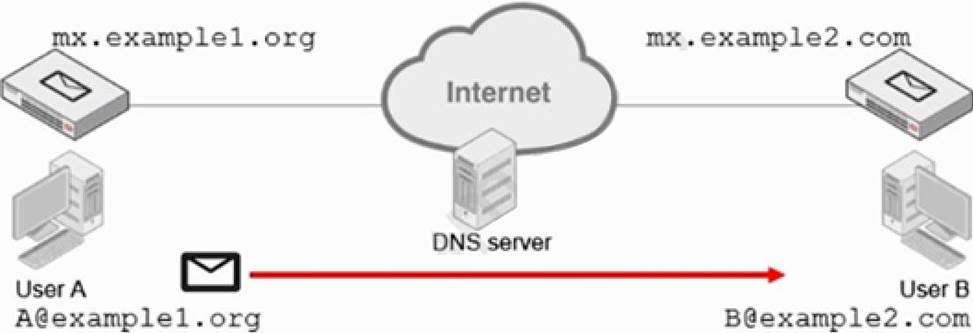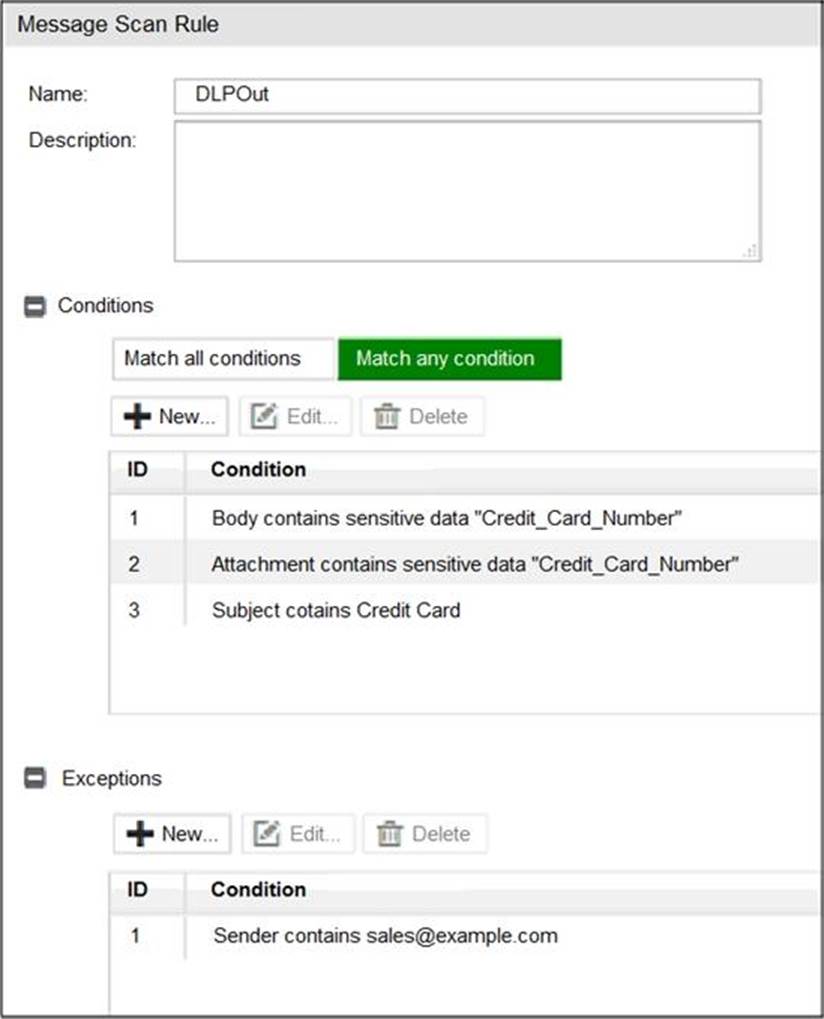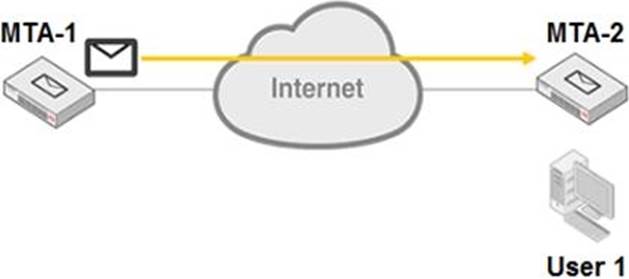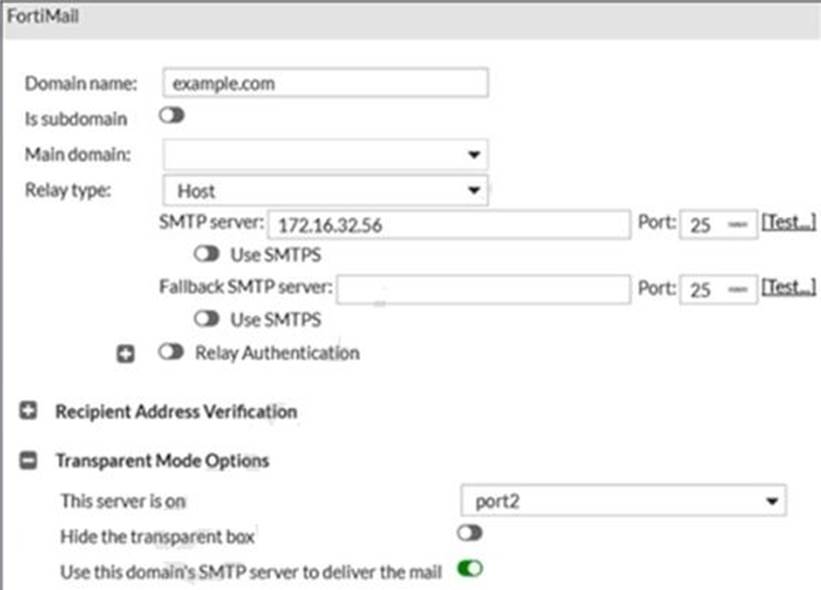Fortinet NSE6_FML-6.4 Fortinet NSE 6 – FortiMail 6.4 Online Training
Fortinet NSE6_FML-6.4 Online Training
The questions for NSE6_FML-6.4 were last updated at Apr 22,2025.
- Exam Code: NSE6_FML-6.4
- Exam Name: Fortinet NSE 6 - FortiMail 6.4
- Certification Provider: Fortinet
- Latest update: Apr 22,2025
If you are using the built-in MTA to process email in transparent mode, which two statements about FortiMail behavior are true? (Choose two.)
- A . MUAs need to be configured to connect to the built-in MTA to send email
- B . If you disable the built-in MTA, FortiMail will use its transparent proxies to deliver email
- C . FortiMail can queue undeliverable messages and generate DSNs
- D . FortiMail ignores the destination set by the sender, and uses its own MX record lookup to deliver email
While reviewing logs, an administrator discovers that an incoming email was processed using policy IDs 0:4:9.
Which two scenarios will generate this policy ID? (Choose two.)
- A . Email was processed using IP policy ID 4
- B . Incoming recipient policy ID 9 has the exclusive flag set
- C . FortiMail applies the default behavior for relaying inbound email
- D . FortiMail configuration is missing an access delivery rule
Refer to the exhibit.

Which two statements about email messages sent from User A to User B are correct? (Choose two.)
- A . User A’s MUA will perform a DNS MX record lookup to send the email message.
- B . mx.example1.org will forward the email message to the MX record that has the lowest preference.
- C . The DNS server will act as an intermediary MTA.
- D . User B will retrieve the email message using either POP3 or IMAP.
A FortiMail administrator is investigating a sudden increase in DSNs being delivered to the protected domain for undeliverable email messages. After searching the logs, the administrator identifies that the DSNs were not generated as a result of any outbound email sent from the protected domain.
Which FortiMail antispam technique can the administrator use to prevent this scenario?
- A . Spam outbreak protection
- B . Bounce address tag validation
- C . Spoofed header detection
- D . FortiGuard IP Reputation
A
Explanation:
Reference: https://docs.fortinet.com/document/fortimail/6.2.0/administration-guide/769204/managing-the-mail-queue
Refer to the exhibit.

Which two message types will trigger this DLP scan rule? (Choose two.)
- A . An email message with a subject that contains the term “credit card” will trigger this scan rule
- B . An email that contains credit card numbers in the body, attachment, and subject will trigger this scan rule
- C . An email message that contains credit card numbers in the body will trigger this scan rule
- D . An email sent from [email protected] will trigger this scan rule, even without matching any conditions
An administrator sees that an excessive amount of storage space on a FortiMail device is being used up by quarantine accounts for invalid users. The FortiMail is operating in transparent mode.
Which two FortiMail features can the administrator configure to tackle this issue? (Choose two.)
- A . Automatic removal of quarantine accounts
- B . Recipient address verification
- C . Bounce address tag verification
- D . Sender address rate control
A,D
Explanation:
Reference:
https://fortinetweb.s3.amazonaws.com/docs.fortinet.com/v2/attachments/9aa62d26-858d-11ea-9384-00505692583a/FortiMail-6.4.0-Administration_Guide.pdf (322, 323)
Refer to the exhibit.

Which statement describes the pre-registered status of the IBE user [email protected]?
- A . The user has received an IBE notification email, but has not accessed the HTTPS URL
or attachment yet. - B . The user account has been de-activated, and the user must register again the next time they receive an IBE email.
- C . The user was registered by an administrator in anticipation of IBE participation.
- D . The user has completed the IBE registration process, but has not yet accessed their IBE email.
D
Explanation:
Reference: https://docs.fortinet.com/document/fortimail/6.4.2/administration-guide/470401/configuring-ibe-users
Refer to the exhibit.

MTA-1 is delivering an email intended for User 1 to MTA-2.
Which two statements about protocol usage between the devices are true? (Choose two.)
- A . User 1 will use logs were generated load the email message from MTA-2
- B . MTA-2 will use IMAP to receive the email message from MTA-1
- C . MTA-1 will use POP3 to deliver the email message to User 1 directly
- D . MTA-1 will use SMTP to deliver the email message to MTA-2
While testing outbound MTA functionality, an administrator discovers that all outbound email is being processed using policy IDs 1:2:0.
Which two reasons explain why the last policy ID value is 0? (Choose two.)
- A . Outbound email is being rejected
- B . IP policy ID 2 has the exclusive flag set
- C . There are no outgoing recipient policies configured
- D . There are no access delivery rules configured for outbound email
Refer to the exhibit.

For the transparent mode FortiMail shown in the exhibit, which two sessions are considered incoming sessions? (Choose two.)
- A . DESTINATION IP: 172.16.32.56 MAIL FROM: [email protected] RCPT TO: [email protected]
- B . DESTINATION IP: 192.168.54.10 MAIL FROM: [email protected] RCPT TO: [email protected]
- C . DESTINATION IP: 10.25.32.15 MAIL FROM: [email protected] RCPT TO: [email protected]
- D . DESTINATION IP: 172.16.32.56 MAIL FROM: [email protected] RCPT TO: [email protected]
Latest NSE6_FML-6.4 Dumps Valid Version with 56 Q&As
Latest And Valid Q&A | Instant Download | Once Fail, Full Refund

